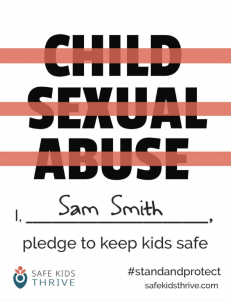Read the Report
Home / Read the Report
Appendix 7: Policies and Procedures
The Centers for Disease Control (CDC) 1 suggests that implementing a child sexual abuse prevention policy and making the changes necessary to protect youth from child sexual abuse in organizations are not easy tasks, but that organizations should take on as many individual strategies to prevent child sexual abuse as they are able. They also offer several steps (paraphrased below) for organizations to take to effectively create, implement and measure child sexual abuse prevention strategies.
- Create a safe space.
- Create an open environment in which employees/volunteers feel comfortable discussing child sexual abuse.
- Have clear goals.
- Know why a certain strategy, policy, or practice is being considered and/or adopted to ensure that the most effective means are used to obtain goals.
- Create a process for developing child sexual abuse prevention policies and practices.
- Obtain buy-in from all levels of the organization so that policies and practices are accepted and owned by everyone.
- Develop the policy. For example, gather a group of stakeholders, such as caregivers, employees/volunteers, and attorneys, to do the work.
- Approve the policy, which includes making sure it complies with organizational policies, state and national laws, and child protective services and law enforcement.
- Adopt the policy.
- Develop a system to track allegations of child sexual abuse and outcomes of cases.
- Inform your organization about the policy.
- Implement the policy.
- Evaluate the policy to continuously measure whether goals are being met. For example, the goal of setting criteria for screening and selection of employees/volunteers may be to make sure that employees/volunteers are appropriate for working with the youth within an organization. Once that goal is agreed upon and the screening and selection policies are adopted, the organization needs to reassess on a regular basis if that goal is being met. If it is not, what needs to be changed to meet the goal? If it is, consider more efficient ways to meet the goal.
- Include appropriate child sexual abuse policies and practices in the prevention plan
- In choosing child sexual abuse prevention policies and practices to adopt, your organization should gather information from several sources.
- Consider the strategies raised in this document.
- Use other organizations’ experiences in this area. For example, look at the resources (Appendix 6) and sample policies (Below). YSOs may also consider discussing prevention policies with other organizations.
SAMPLE POLICIES AND PROCEDURES
- National Policy Statements. American Youth Soccer Organization. (https://ayso.org/privacy-policy/)
- Model Policies and Procedures for Response to Allegations of Sexual Abuse. National Catholic Services, LLC (https://www.virt us.org/virtus/AllegationResponse.pdf)
- Model Policies for the Protection of Children and Youth from Abuse. The Church Pension Group, in partnership with The Nathan Network.(https://extranet.generalconvention.org/staff/files/download/21313)
- Sample Sexual Abuse and Misconduct Prevention Policy. The Glatfelter Healthcare Practice.(https://www.vfis.com/Portals/vfis/emergency-service-operations/Sexual-Abuse-and-Misconduct-VFIS.pdf?ver=2019-06-05-080432-327)
- Sample Child Protection Policy for an Organization. Cal Ripken, Sr. Foundation. (https://www.acacamps.org/sites/default/files/resource_library/CRSF-Template-National-Child-Protection-Policy.pdf)
- Sample Child Abuse Awareness/Prevention Policy. Clemson University.(https://www.clemson.edu/administration/compliance/documents/18-12-17reportingabuse.pdf )
- Child Abuse Prevention Policy and Procedures. YMCA of the Oranges. (https://secure.ethicspoint.com/domain/media/en/gui/19089/Child_Abuse_Prevention_Policy.pdf)
- Child Abuse & Maltreatment Prevention Policy. The Juilliard School, NY. (https://www.juilliard.edu/school/about/policies-consumer-information/working-minors-policy)
- Child Abuse Prevention Resources. American Camp Association. (https://www.acacamps.org/resource-library/child-abuse-prevention-resources)
- Rotary Youth Protection Guide: Sample District Youth Protection Policy (Page 17). Rotary International, IL. (https://my.rotary.org/en/document/rotary-youth-protection-guide)
1 Saul J, Audage NC. Preventing Child Sexual Abuse Within Youth-serving Organizations: Getting Started on Policies and Procedures. Atlanta (GA): Centers for Disease Control and Prevention, National Center for Injury Prevention and Control; 2007.
- Acknowledgements
- Executive Summary
- Introduction
- How to Read This Report
- Mission & Purpose of Taskforce
- A Brief History of How the Taskforce Was Organized
- The Charge of the Legislative Language
- Key Sections
- Section 1: Developing Policies and Procedures for Child Protection
- Section 2: Screening and Background Checks for Selecting Employees and Volunteers
- Section 3: Code of Conduct and Monitoring
- Section 4: Ensuring Safe Physical Environments and Safe Technology
- Section 5: Recognizing, Responding to, and Reporting Allegations and Suspicions of Child Sexual Abuse
- Section 6: Training About Child Sexual Abuse Prevention
- Additional Considerations
- Applying the Framework: A Five-Year Plan
- Appendices
- Section-Specific Appendices
- Downloadable Resources

Take the Pledge to Keep Kids Safe
Join us and commit to learning how you can protect the children/youth you serve.
Sign Up to Access Your Learning Center
Customized child sexual abuse prevention guidelines to meet the unique needs of any organization that serves children.
- Evidence-informed guidance
- Actionable prevention steps
- Keeps track of your progress
- Tailored learning tracks


